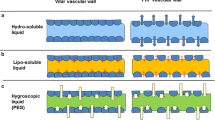Abstract
The rapid development of computed tomography (CT) and magnetic resonance imaging (MRI) led to the introduction and establishment in postmortem investigations. The objectives of this preliminary study were to describe the imaging appearances of the early postmortem changes of blood after cessation of the circulation, such as sedimentation, postmortem clotting, and internal livores, and to give a few first suggestions on how to differentiate them from other forensic findings. In the Virtopsy project, 95 human corpses underwent postmortem imaging by CT and MRI prior to traditional autopsy and therefore 44 cases have been investigated in this study. Postmortem alterations as well as the forensic relevant findings of the blood, such as internal or subcutaneous bleedings, are presented on the basis of their imaging appearances in multislice CT and MRI.









Similar content being viewed by others
References
Aghayev E, Yen K, Sonnenschein M et al (2004) Virtopsy post-mortem multi-slice computed tomography (MSCT) and magnetic resonance imaging (MRI) demonstrating descending tonsillar herniation: comparison to clinical studies. Neuroradiology 46:559–564
Barkhausen J, Hunold P, Eggebrecht H et al (2002) Detection and characterization of intracardiac thrombi on MR imaging. Am J Roentgenol 179:1539–1544
Berg S (1950) Das postmortale Verhalten des Blutes. Dtsch Z Gesamte Gerichtl Med 40:1–75
Bohm E (1987) Structural principles of hemostatic processes. Forensic Sci Int 33:7–22
Bohm E, Hochkirchen KH (1983) Ultrastructure of intravital, postmortem and autolysed fibrin. Forensic Sci Int 21:117–127
Farahani K, Saxton RE, Yoon HC et al (1999) MRI of thermally denatured blood: methemoglobin formation and relaxation effects. Magn Reson Imaging 17:1489–1494
Foroughi E (1971) Serum changes in drowning. J Forensic Sci 16:269–282
Hellerich U, Bohnert M, Pollak S (2001) Hypostasis-induced changes in the breast area. Arch Kriminol 207:162–169
Huisman TA (2004) Magnetic resonance imaging: an alternative to autopsy in neonatal death? Semin Neonatol 9:347–353
Imaizumi T, Chiba M, Honma T et al (2003a) Detection of hemosiderin deposition by T2*-weighted MRI after subarachnoid hemorrhage. Stroke 34:1693–1698
Imaizumi T, Chiba M, Honma T et al (2003b) Dynamics of dotlike hemosiderin spots associated with intracerebral hemorrhage. J Neuroimaging 13:155–157
Jackowski C (2003) Macroscopical and histological findings in comparison with CT- and MRI- examinations of isolated autopsy-hearts. Thesis, University of Magdeburg
Jackowski C, Schweitzer W, Thali M et al (2005) Virtopsy: postmortem imaging of the human heart in situ using MSCT and MRI. Forensic Sci Int 149:11–23
Jeanmonod R, Staub C, Mermillod B (1992) The reliability of cardiac haemodilution as a diagnostic test of drowning. Forensic Sci Int 52:171–180
Laiho K, Penttila A (1981) Autolytic changes in blood cells and other tissue cells of human cadavers. I. Viability and ion studies. Forensic Sci Int 17:109–120
Noriko T (1995) Immunohistochemical studies on postmortem lividity. Forensic Sci Int 72:179–189
Penttila A, Laiho K (1981) Autolytic changes in blood cells of human cadavers. II. Morphological studies. Forensic Sci Int 17:121–132
Quan L, Zhu BL, Fujita MQ et al (2003) Ultrasonographic densitometry of the lungs at autopsy: a preliminary investigation for possible application in forensic pathology. Leg Med (Tokyo) 5(Suppl 1):S335–S337
Rammer L, Gerdin B (1976) Dilution of blood in fresh water drowning. Post-mortem determination of osmolarity and electrolytes in blood, cerebrospinal fluid and vitreous humor. Forensic Sci 8:229–234
Roberts IS, Benbow EW, Bisset R et al (2003) Accuracy of magnetic resonance imaging in determining cause of sudden death in adults: comparison with conventional autopsy. Histopathology 42:424–430
Sannohe S (2002) Change in the postmortem formation of hypostasis in skin preparations 100 micrometers thick. Am J Forensic Med Pathol 23:349–354
Schleyer F (1958) Postmortale Blutviscosität, Blutzellvolumen, osmotische Erythrocytenresistenz und Blutkörperchensenkung in Beziehung zu Leichenalter und Todesursache. Virchows Arch 331:276–286
Shiotani S, Kohno M, Ohashi N et al (2002) Postmortem intravascular high-density fluid level (hypostasis): CT findings. J Comput Assist Tomogr 26:892–893
Shiotani S, Kohno M, Ohashi N et al (2004) Non-traumatic postmortem computed tomographic (PMCT) findings of the lung. Forensic Sci Int 139:39–48
Skopp G, Potsch L, Lutz R et al (1998) Hemoglobin diffusion across a venous wall: an experimental study. Am J Forensic Med Pathol 19:372–376
Stammers AH, Vang SN, Mejak BL et al (2003) Quantification of the effect of altering hematocrit and temperature on blood viscosity. J Extra Corpor Technol 35:143–151
Takeichi S, Wakasugi C, Shikata I (1984) Fluidity of cadaveric blood after sudden death: part I. Postmortem fibrinolysis and plasma catecholamine level. Am J Forensic Med Pathol 5:223–227
Takeichi S, Wakasugi C, Shikata I (1985) Fluidity of cadaveric blood after sudden death: part II. Mechanism of release of plasminogen activator from blood vessels. Am J Forensic Med Pathol 6:25–29
Takeichi S, Tokunaga I, Hayakumo K et al (1986) Fluidity of cadaveric blood after sudden death: part III. Acid-base balance and fibrinolysis. Am J Forensic Med Pathol 7:35–38
Thali MJ, Yen K, Schweitzer W et al (2003) Virtopsy, a new imaging horizon in forensic pathology: virtual autopsy by postmortem multislice computed tomography (MSCT) and magnetic resonance imaging (MRI)—a feasibility study. J Forensic Sci 48:386–403
Thomsen H, Krisch B (1994) The postmortem activation status of platelets. Int J Legal Med 107:111–117
Thomsen H, Kaatsch HJ, Krisch B (1999) How and why does the platelet count in postmortem blood change during the early postmortem interval? Forensic Sci Int 101:185–194
Yen K, Sonnenschein M, Thali MJ et al (2005) Postmortem multislice computed tomography and magnetic resonance imaging of odontoid fractures, atlantoaxial distractions and ascending medullary edema. Int J Legal Med 119:129–136
Acknowledgements
We would like to thank Elke Spielvogel, Christoph Laeser, Carolina Dobrowolska, and Verena Beutler for their excellent help during the scanning and Urs Königsdorfer and Roland Dorn for their experienced assistance at autopsy. We are also grateful to Therese Périnat for the histological preparations.
Author information
Authors and Affiliations
Corresponding author
Rights and permissions
About this article
Cite this article
Jackowski, C., Thali, M., Aghayev, E. et al. Postmortem imaging of blood and its characteristics using MSCT and MRI. Int J Legal Med 120, 233–240 (2006). https://doi.org/10.1007/s00414-005-0023-4
Received:
Accepted:
Published:
Issue Date:
DOI: https://doi.org/10.1007/s00414-005-0023-4



